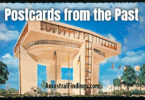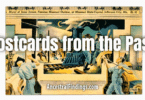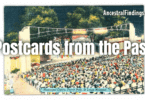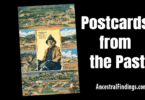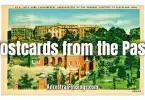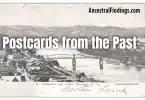Broadway in Its Flashiest Years
This one caught my eye for a completely different reason than most of the postcards I’ve written about. It’s not a quiet street scene or a charming old building—it’s people. A whole lineup of them. Dancers, performers, maybe a few singers too, all standing in formation in front of a dramatic backdrop. They’re dressed in full costume—fringe, sequins, feathers—ready to perform, or maybe just wrapping up another night’s set.
The caption at the bottom reads: The Ensemble of “The Famous Hollywood Cabaret” Restaurant, Broadway at 48th St., New York City. It says a lot in just a few words. This wasn’t just a restaurant—it was a place where dinner came with a full night of entertainment. And this postcard doesn’t just show a building or a business—it captures a whole slice of nightlife in one of New York’s most legendary neighborhoods.
A Window into Old-School Cabaret Culture
The Hollywood Cabaret was one of many spots along Broadway during the golden age of live entertainment. It’s hard to explain just how central places like this were to the city’s identity. From the 1930s through the early 1950s, supper clubs and cabarets were everywhere. You could go out for a steak and end up sitting front row for a dance routine, a comic act, or a full orchestra-led revue. These places blended glamour with grit, elegance with noise, and everyone—from the well-to-do to tourists passing through—wanted to be part of it.
Broadway at 48th was right in the thick of it. Just steps away from Times Square, surrounded by theaters and neon signs, this part of Manhattan never really went to sleep. The clubs opened in the early evening and didn’t shut their doors until well after midnight. Inside, the air was thick with cigarette smoke, perfume, and the hum of conversation. Tables were packed tightly, drinks came quickly, and performers kept the energy high.
Taking a Closer Look at the Postcard
The performers in the photo are standing tall, confident, and camera-ready. Most are women in coordinated outfits—some long and flowing, others short and meant to show off quick-moving feet on stage. A few men stand at either end, possibly bandleaders or choreographers. The backdrop behind them is art deco all the way—shiny, geometric, and theatrical.
You can almost hear the echo of big band music just looking at the image. The rustle of satin dresses, the soft clink of highball glasses, the shuffle of feet rehearsing in the back hallway—it’s all there if you imagine it. The photo doesn’t give us names, but you know these weren’t hobbyists. These were seasoned performers, working the nightclub circuit with precision and style, many of them hoping to land a bigger gig in a Broadway production or a radio broadcast.
The Larger Broadway Story
New York’s nightlife in that era was more than entertainment—it was culture. The Hollywood Cabaret would’ve been competing with dozens of other spots offering similar lineups. The Latin Quarter, the Copacabana, and the Stork Club were all major players. But even the smaller places like this one held their own by building loyal crowds, crafting tight shows, and providing a taste of glamour people craved, especially during and after the Great Depression.
The performers—especially the women—worked hard under tough conditions. Rehearsals ran long. Outfits weren’t always comfortable. And while the stage was full of lights and energy, backstage was a world of hustle. Still, the draw of the spotlight kept them going, and many found lifelong careers in entertainment, even if their names never made it to marquees.
What Happened to the Hollywood Cabaret?
By the late 1950s, things began to change. Supper clubs declined as television took over living rooms. Tastes shifted. Younger generations gravitated toward rock and roll, beat poetry, and different ways of gathering. Rising rents in Manhattan forced many of the small and mid-sized venues to close or be absorbed into larger buildings. The site of the Hollywood Cabaret is likely part of a modern hotel or office structure now—completely unrecognizable from what it once was.
That story is familiar across Manhattan. The buildings change, the lights get brighter, but the stories behind them don’t always stay in plain sight. Postcards like this help pull a little of that history back into view.
The Postcard as a Time Capsule
The back of this card is blank—no message, no date, just a publisher mark from E. C. Kropp Co. in Milwaukee and the name of the photographer: Korman. This wasn’t mass-produced for tourists. It was more of a keepsake. Maybe someone picked it up after attending the show. Maybe it was sold at the club’s entrance for a dime, meant to be slipped into a purse or suit pocket as a memory of the night.
It’s amazing how something so simple—a piece of cardstock with an image and a line of text—can carry so much history. This isn’t just a picture of people. It’s a picture of what nightlife used to be, of the spirit that helped shape mid-century New York.
A Final Bow
What sticks with me most is the way this card captures not just the look of the place, but the feel of it. The effort, the sparkle, the rhythm—it’s all frozen in that one photo. These performers, anonymous to us now, were once part of a scene that made Broadway buzz long after the theaters let out.
Let Me Know What’s in Your Collection
If you’ve ever come across something like this—whether it’s a card, a flyer, or a snapshot from a place that doesn’t exist anymore—I’d love to hear the story. And if you’ve got a postcard you’d like to share, just head to the Contact page and ask for my mailing address. I’d be glad to take a look and maybe even feature it here.

